Here you will find all of the images to date from my Year of Photos challenge. While the primary distribution of the photos is via email, I wanted to make them accessible to those that may have joined the list late and even those that have not joined it yet.
Click on any of the images below to open up that month’s collection of images. Once inside click on any of the individual images to start a full-screen slideshow of that month’s photos.
Enjoy!
Chris
November
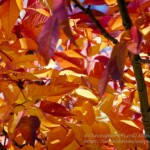
A shot of pure fall color today in a semi-impressionistic image. You can't see the tree for the leaves on this gorgeous Ash tree in full color, but sometimes just a part of something is greater than the whole.
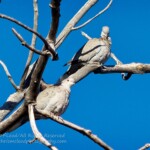
oday's image is the first from 2015 in my backlog and is of two Eurasian collared doves. These birds are relatively new arrivals in Colorado (they arrived in the continental US in 1974 and have spread to all 50 states since then) and are year-round residents having adapted to the cold weather. This pair is hanging out in our ash tree and doing a very good job of blending in with the bare branches on this very cold January day. The contrast of their feathers in the sun vs. the very blue sky makes this one pop.
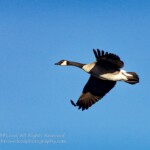
The seagulls weren't the only birds out on this late December day; the Canada geese were as well. This lone goose was trying to catch up to the larger group that was headed for another pond to settle in for the night. This shot is another good example of the aerodynamic nature of these birds when in flight as well as a great contrast with the clear blue (nearly) winter sky. I can hear the honking of the flock every time I look at this one.

The last of the seagulls for a while, promise :). While this is similar to the previous shot, there are some differences that I think make it worthy of inclusion. The gull in this instance isn't looking for something to eat; it's just soaring in the evening sun. If I remember right at some point during the shoot, the sun got too low and wasn't illuminating the water anymore so there was no way to see the fish. Rather than leaving, the gulls just kept soaring around and in my mind, simply enjoying the sunlight and the beautiful day. I have commented on this behavior in seagulls previously in that they, more than any other bird I have photographed, seem to spend more time just flying than any other species. With as aerodynamic as they can be (check out the sleek lines on how this one is holding himself), why not?
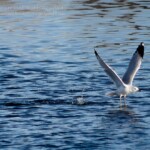
One constant in my photographic history is seagulls; they are everywhere I go and as such everywhere in the backlog. I came across these guys one December day (12/19/2014 to be precise) fishing in one of the few bodies of water in the area that wasn't frozen over. They would circle overhead and then suddenly dive in to catch whatever fish they had spied. Today's image is of one taking off after having tried her luck and failed on catching a fish. The time of the year (two days before solstice) and the time of day (about 4p) makes for some dramatic light as she strains to take to the sky. Unfortunately, the low light meant I had to dial up the ISO so it's not quite as sharp as I would have preferred. But still in the overall, not too bad.

Another shot of the solstice seagulls today, this one shows a diligent gull with his eye on the lake hoping to see the silvery flash that indicates fish for dinner. As we know the eventual result (see this image for what the little fish they are hunting for look like) it seems like a lot of work for very little return. Regardless, the gulls soar, wheel and dive over and over trying to get the elusive minnows, and it all starts with a cocked head scanning the surface the slightest sign.

When winter sets in and you like flowers, you need to move them into the house with you. While we do a lot of live plants in the house over the weekend, this particular picture is of some cut flowers (roses in this case) in the early morning sunlight — a little bit of spring in winter.

Today's shot is of someone else's art. It is somewhat like the shots of the street art I have posted before but on a slightly different level. Both of the carvings central to this image were done by my father-in-law Joe Esquibel and were on display at the annual Regis University Santos* art show. What I genuinely liked about this one, aside from the fantastic artistry, was that we have two pieces that have the same general theme (The Virgin of Guadalupe) that follow the standard forms for that image (the stars on the mantle and the sunburst surrounding her) but interpreted in very different ways. I also like the staging of the two, where you could directly compare and contrast them, and the lighting is fantastic.

While Veterans Day passed a few weeks ago, I only came across this photo in my backlog a few days ago. This one was taken on 11/11/2014 at Fort Logan National Cemetary in Denver. The central stone is for my Uncle Bud, and this was a family trip out to visit the grave. I think with the marble and the snow the choice to go black and white was a natural one. I love that while the stones are uniform in shape, each is unique in its 'marbling' so that no two are just alike, just like the people who they commemorate.
Instead of simply converting it to black and white, I used a program called Film Pack to give it a retro texture. For those that are interested, the treatment and grain pattern is that of Kodak T-Max 400 film. If you go to the larger image (click through) you will be able to see the grain. I think it gives it a nice, old time feel.
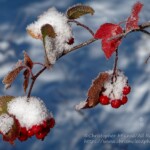
I usually don't come across turkeys in my travels, so you will have to make do with another snow/fall mashup shot. I am not sure what kind of berries these are, but the red against the snow is a great contrast and brings back the memory of the coldness of the morning like it was yesterday. I was hopeful for some snow this year on Thanksgiving, but it looks like we will miss it for this year. Well, there is lots of winter left to come

As the arrival of the finches foretold, snow was soon to come. These are the same grasses that we saw a few days ago blowing in the wind, now covered with snow and ice on a cold still morning. The non-native grasses I feel always have it the worst as they don't seem to know what's coming. They were still full green just a week prior, and now they are frosted. They do seem to survive year over year, so they are obviously hearty plants in addition to being beautiful.

As fall progressed in 2014 certain signs of the winter to come started to appear. As you can see in this photo, the gray-crowned rosy finches are back which must mean it is freezing where they are coming from as it is getting ready to snow locally. The little one in this image almost seems to me to be posing for a formal portrait with the look-back over his shoulder. I had been photographing them for a few seasons by this point, so maybe she was! Regardless, there is no fear on their part, and I was pleased to see them back, heralding the changes to come.
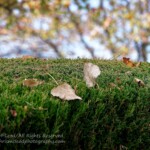
Today's image is one I took while eating lunch in my car at a park near work. I don't know why the leaves lying on the bush caused me to bring out the camera, but they did. As I may have mentioned, fall is my favorite season bringing both happiness and sadness, and this image speaks of both to me.
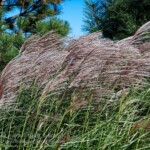
While the flowers are dying and the leaves have all turned colors, the non-native decorative grasses are still green even late into the fall. This shot is a result of me trying to capture them in the wind for my dad who always is talking about how great they look. While this image isn't bad (you can definitely tell the grass is windblown), it doesn't quite stack up to idly sitting and watching the seed heads wave too and fro as the wind gusts on a crisp fall day. As with many things, sometimes seeing it live is the best but a picture is better than nothing and can help spark the memory even years later.
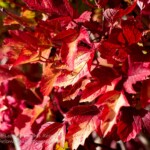
I went through a time where I thought fall leaf images were cool. This one is of a maple tree and as you can see we have a different (deeper) color palette and aside from the leaf shapes being different the texture of them is quite a contrast as well with these being much rougher. I do see as I go through these old shots that I need to pay more attention to my depth of field. I am all for a soft focus on the edges, but it's not always the best choice.
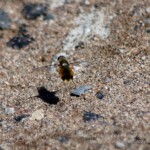
Today is the end of the mini-series of bees, and the shot is atypical in that the bee isn't busy getting pollen. If you go looking for bees and they aren't around the flowers, check for any standing water in the area as it takes a lot of water for them to make honey. This one was flying along the sandy bank of the Colorado River looking for a drink that wasn't flowing briskly. I just happened to notice him buzzing around while I was sitting on the beach taking photos of other things. If you don't react violently to them they just kind of buzz along, minding their own business and they are fascinating to watch.
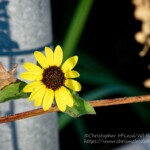
One more of the stubborn late fall flowers, this time a sunflower. I like this one as the flower is full and healthy even as you can see the impact the frost has had on the leaves of the plant. Also, the enlarged shadow of the flower on the post is a nice bonus along with the dead vegetation to the right that obviously isn't as hardy as the sunflower.
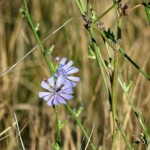
While the milkweed plants have gone to seed, some plants are still putting out flowers more than a week after the first freeze. Not to miss out on an opportunity a pollinator is gathering what is sure to be nearly the last of the pollen of the season. It's fantastic that the activity keeps happening right up until it absolutely can't anymore. And even after the flowers and bees are gone, the animals keep things going all winter.
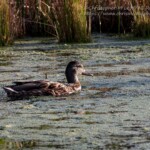
The great heron may have been the biggest bird left, but not the only one. This female mallard was hanging out in one of the small pools of water adjacent to the main lake and as you can see the water has gone a bit fetid. While certainly wouldn't have wanted to swim in this, she doesn't seem to mind, and as an aquatic plant eater, it might be just the place for her to fuel up for the long flight ahead.
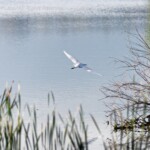
The plants aren't the only thing affected by the change of seasons; this lone great egret is looking for a meal so it can continue its migration. The leaves are off the trees, and the reeds and grasses have changed color, and it is time to get out of Colorado and head someplace warm. This was one of the few birds left in the refuge and the largest of them all; everyone else was already gone. I often see lone birds in the fall, and wonder, are they just traveling alone or was the thought of the long flight just too much? And if they decided to stay behind, what becomes of them?
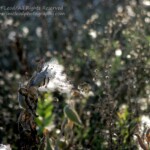
Not much to add to the discussion on milkweed pods/seeds from yesterday, except to add this was my choice of the two in the beauty department. Hope you enjoyed them both. And happy Veteran's day to all, especially any vet's following along.
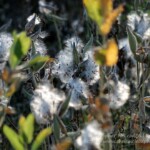
For those keeping score at home the photos are still from 2014 and after a detour to Ireland in June we and California in August we are back in Colorado in September. Fall has arrived and is bringing changes to both the plant and animal life, closing out the cycle that started in spring. I have a couple of photos of milkweed pod's going to seed, and I couldn't decide which was best, so I will be sending both with a preference to today's as my wife liked it best (hey, beats flipping a coin). Milkweed is the preferred food of monarch butterfly caterpillars, and there are vast swaths of it around the lake at the local wildlife sanctuary. Mix in the early morning sun and the changing color and there you go, a picture that screams fall.
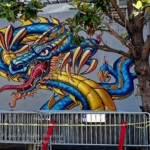
As we moved to Chinatown in San Fransisco, I came across some more fantastic street art. This beautiful dragon was also painted on a temporary construction screening wall, much like the art from downtown Cork previously. This one also shares in common with that painting, as well as the ones in Bengaluru, incredibly vibrant colors which certainly makes them all eye-catching. It makes me a bit sad to realize that this dragon probably went into a dumpster after the work on the site was done. I am glad I happened by when he was still standing guard. That is the crux of so much photography, catching something in the moment that won't be there later, preserving a little slice of time more accurately than our memory could. It's magic.
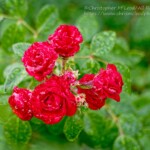
One of the things that I have learned, and relearned as I forget and need to be reminded, is that it is always best to have your camera with you anytime you are in the world (i.e., all the time). This picture was taken in the drive-thru of a local Starbucks early one September morning where it had gotten below freezing, but the irrigation sprinklers were still running. The result was this bunch of roses encased in ice, perfectly preserved in a glassy shell. I am very happy that the drive-thru was running slow enough I could get my camera out of the bag and get the shot. As a side note, the ice didn't kill the roses. I have another picture of them taken several days later after it had warmed up and they were just fine. Apparently, the ice protects the plants from getting colder than 32° F (0° C), and so they weren't damaged. It turns out this is a trick that citrus growers in Florida use to protect their trees when it frosts. Glad I had my camera, I got a great shot and learned about how to protect flowers/fruit.
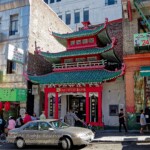
Another shot from Chinatown San Fransisco today, one that makes me smile. Most of the Chinatown area is pretty typical urban construction, albeit with a little Asian flair, but this building stood out. I certainly didn't expect to see a pagoda style building after hours of trudging up and down hills through miles of western architecture which is why I guess this was such a breath of fresh air. As you can see it is closely surrounded on three sides and is in a lot the same size as the surrounding buildings so they must have had to very carefully demo what used to stand there and then pack in the biggest pagoda they could for the space available. Add a dash of red and gold, and you have the jewel of the neighborhood.
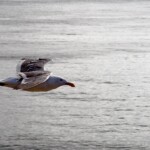
Couldn't resist another seagull flyby, this one from the northern coast of California. As noted, if I didn't keep track of when and where the shots were taken it could get confusing fast. This guy and his buddies were doing eye level passes, and this was the best of the shots. Things to look out for on the large version of this (click the image) is the drop of water hanging off his beak and that you can see sunlight through the nostril opening on his beak. Fun fact with these guys, the openings there are just holes so that he can breathe with his beak closed, they open right into his mouth. You have to be aligned just right to see it, and in this case, I was.
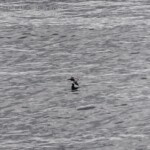
Another shot off the northern California coast today. This one of some brown pelicans that were a bit further out than the cormorant of yesterday and thus were past the breaking waves and flying over some calm water. The brown pelicans here, like the ones in Florida, really seem to like soaring and then swooping low and skimming across the surface of the water and these three were doing an excellent job of taking advantage of the wind and big wings to sail with a minimum of wing flapping. I never saw this group skim for something in the water, but there were others that were doing so. This is very different from how the American white pelicans feed, which is floating around on the surface and scooping with their bills, but it is the same as the speckled bill pelicans of India. Without any definitive information, I still feel this has to do with the size of the birds and the presence or lack of predators in the water. Or I suppose, in this case, waves that would make floating difficult. Regardless of how they feed, pelicans of all sizes and colors still fascinate me.
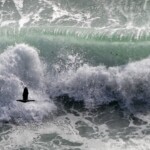
This cormorant could be anywhere as I have seen them all over the world but in this case, it is flying along the crashing waves of the Big Sur area of northern California. A lot of similarities in this west coast to the one seen recently in Ireland but as you can see the surf here is a bit more aggressive. If you didn't have the green tinge to the water this literally could be a black and white image as the foam on the waves is in stark contrast to the jet black feathers. I don't know what the cormorants are looking for here, their typical habitat in my experience is calm waters where they dive for fish, but there were a lot of them skimming the waves and crossing just in front of them. Perhaps it was just fun?
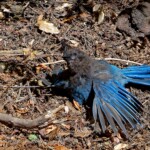
This photo is an excellent example of some of the odd bird behavior I come across when I am out with my camera, this time from the redwood forests of the big basin on the southern peninsula of San Fransisco Bay. I don't know what got into this particular stellar's jay, but it decided to plop on the ground to get some dust on its feathers right in front of us and proceeded to put on a show. The look it is giving us in this one seems to say, why are you watching me bathe? Regardless of what the goal was, we got a good look at the beautiful blue feathers before the show was over and it took off.
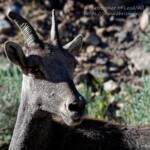
With my main focus being on birds I don't have a lot in my portfolio as far as mammals go, and when it gets too large mammals, I am even shorter. This wild goat got into the mix through sheer serendipity as it was standing by the road as we drove along the backcountry along the Colorado River. Again, I believe he as curious as we were and posed for several minutes while we checked each other out. Of all the shots I liked this one the best due to the shadow from his ear providing the contrast across his face. Chalk one up again for late day sun.